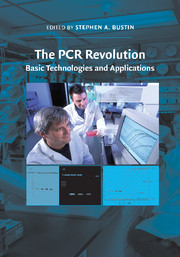Book contents
- Frontmatter
- Contents
- Contributors
- Foreword by Russell Higuchi
- Preface
- I BASIC TECHNOLOGIES
- II APPLICATIONS
- 10 Polymerase chain reaction–based methods for the detection of solid tumor cancer cells for clinical diagnostic and prognostic assays
- 11 Polymerase chain reaction and infectious diseases
- 12 Polymerase chain reaction and respiratory viruses
- 13 Polymerase chain reaction and severe acute respiratory syndrome
- 14 The MMR vaccine, measles virus, and autism – A cautionary tale
- 15 Noninvasive prenatal diagnosis using cell-free fetal nucleic acids in maternal plasma
- 16 Polymerase chain reaction–based analyses of nucleic acids from archival material
- 17 Microarrays and quantitative real-time reverse transcriptase–polymerase chain reaction
- 18 Polymerase chain reaction in the detection of genetic variation
- 19 Polymerase chain reaction: A blessing and a curse for ancient deoxyribonucleic acid research
- Index
- Plate section
- References
18 - Polymerase chain reaction in the detection of genetic variation
Published online by Cambridge University Press: 25 January 2011
- Frontmatter
- Contents
- Contributors
- Foreword by Russell Higuchi
- Preface
- I BASIC TECHNOLOGIES
- II APPLICATIONS
- 10 Polymerase chain reaction–based methods for the detection of solid tumor cancer cells for clinical diagnostic and prognostic assays
- 11 Polymerase chain reaction and infectious diseases
- 12 Polymerase chain reaction and respiratory viruses
- 13 Polymerase chain reaction and severe acute respiratory syndrome
- 14 The MMR vaccine, measles virus, and autism – A cautionary tale
- 15 Noninvasive prenatal diagnosis using cell-free fetal nucleic acids in maternal plasma
- 16 Polymerase chain reaction–based analyses of nucleic acids from archival material
- 17 Microarrays and quantitative real-time reverse transcriptase–polymerase chain reaction
- 18 Polymerase chain reaction in the detection of genetic variation
- 19 Polymerase chain reaction: A blessing and a curse for ancient deoxyribonucleic acid research
- Index
- Plate section
- References
Summary
IN THE BEGINNING
When the polymerase chain reaction (PCR) burst onto the scene in the mid-1980s, its usefulness for genetic analysis was immediately recognized. Indeed, the first publication of the PCR method was on its use in the prenatal diagnosis of sickle cell anemia. When the use of thermostable deoxyribonucleic acid (DNA) polymerases and programmable thermocyclers made PCR a commonly used method in the laboratory, the detection of genetic variation became a much easier enterprise. Instead of relying on laborious approaches such as restriction fragment length polymorphism (RFLP) analysis or DNA sequencing of complementary DNA clones to detect genetic variation, PCR allowed the “extraction” of a specific locus of the genome and produced sufficient quantities of it for further analysis. The main contributions of PCR to the detection of genetic variation are in three areas: amplification of small, unique regions of the genome harboring DNA sequence variants; discrimination of allelic differences between genomes; and amplification of products of other allelic discrimination reactions for detection by conventional means.
In the early days of the PCR revolution, the main obstacles to the deployment of PCR for genetic variation were the paucity of genomic sequence information for PCR primer design, the relatively high cost of oligonucleotide synthesis, and the laborious procedures used in DNA sequencing. Fortunately, automated DNA synthesis and DNA sequencing instruments became available in the early 1990s and the initial genomic mapping phase of the Human Genome Project provided the impetus to produce genetic markers based on PCR. As the speed of DNA sequencing and oligonucleotide synthesis increased while their cost went down, PCR became the principal approach to genetic analysis.
- Type
- Chapter
- Information
- The PCR RevolutionBasic Technologies and Applications, pp. 276 - 283Publisher: Cambridge University PressPrint publication year: 2009



